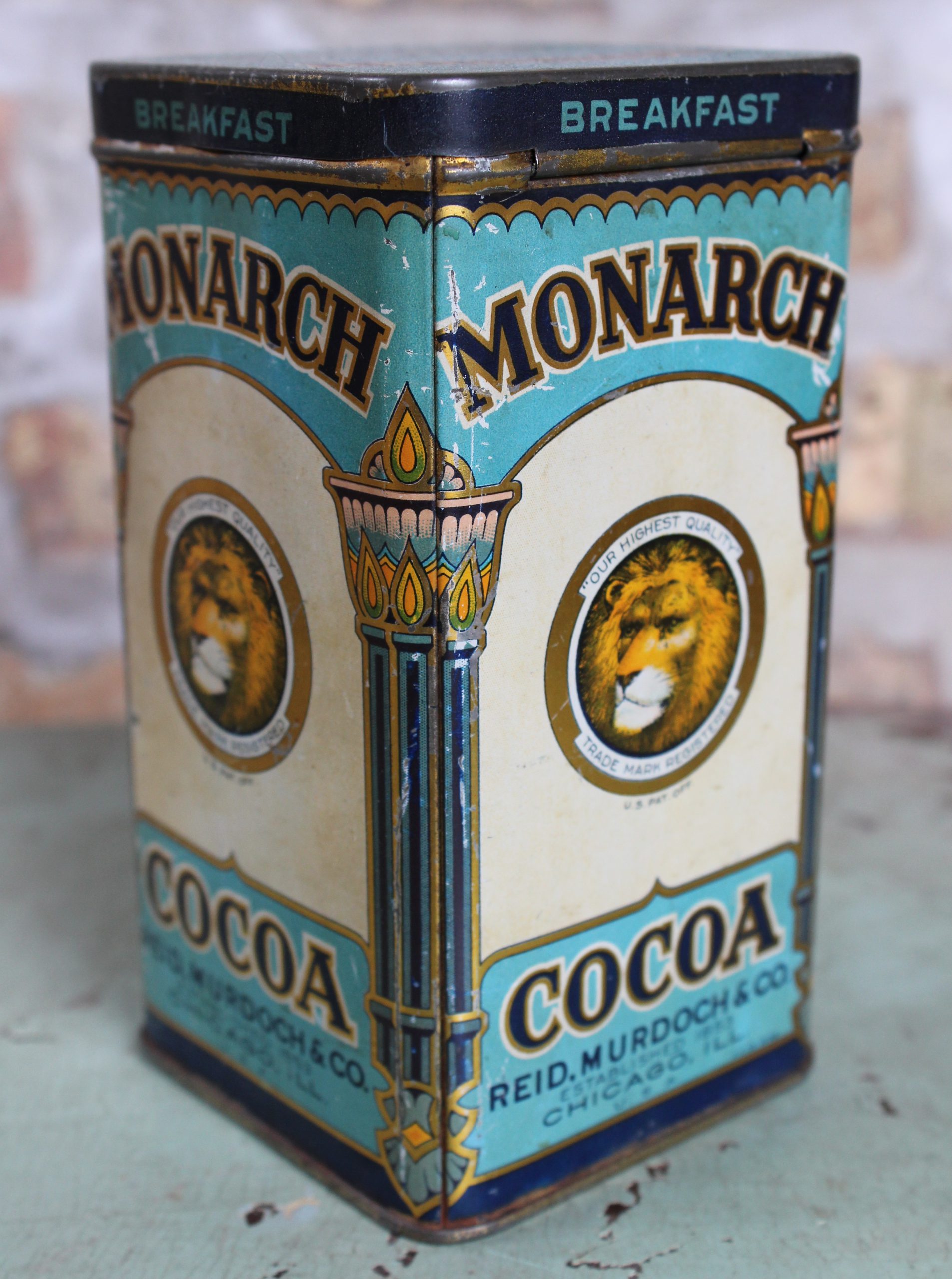
Museum Artifact: Monarch Cocoa Tin, 1920s
Made By: Reid, Murdoch & Co., 325 N. LaSalle St., Chicago, IL [River North]
“When a Chicago business attains dimensions which overshadow those with which it may be compared, it becomes in the broadest sense a Chicago institution and belongs in a manner to every Chicagoan. It stands for Chicago pluck, Chicago brains and Chicago energy.”— Frank H. Spearman, writing about Reid, Murdoch & Co. in the Sunday Times-Herald, March 26, 1899
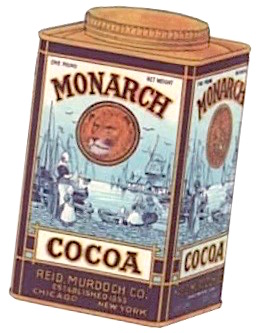 For the better part of a century, Reid, Murdoch & Company was the granddaddy of gargantuan wholesale grocery establishments in a city that was home to plenty of them. From humble pre-Civil War roots on the Western frontier, the business evolved into a leading manufacturer and importer of canned food products, with more than 250 different offerings available under its popular Monarch label by the 1920s—including jams, jellies, pickles, coffees, teas, and the colorful cocoa tin in our museum collection. These products were sold exclusively to independent merchants rather than chain stores, making Reid-Murdoch one of the last great champions of the mom & pop shop—despite existing as a coast-to-coast corporation in its own right.
For the better part of a century, Reid, Murdoch & Company was the granddaddy of gargantuan wholesale grocery establishments in a city that was home to plenty of them. From humble pre-Civil War roots on the Western frontier, the business evolved into a leading manufacturer and importer of canned food products, with more than 250 different offerings available under its popular Monarch label by the 1920s—including jams, jellies, pickles, coffees, teas, and the colorful cocoa tin in our museum collection. These products were sold exclusively to independent merchants rather than chain stores, making Reid-Murdoch one of the last great champions of the mom & pop shop—despite existing as a coast-to-coast corporation in its own right.
“The question is often asked—‘Why are Grocers who own and operate their own stores the ONLY ones from whom MONARCH Food Products can be purchased,’” read a 1923 Reid-Murdoch advertisement. “Here is the answer. MONARCH Food Products are manufactured and distributed by Reid, Murdoch & Co., who are unalterably opposed to price discrimination, to selling to a grocer on the right side of the street at one price and to a group of stores on the other side of the street at a lower price.
“. . . [An independent grocer] owns and operates his own store, and, like you, has an interest in the community in which he lives and works. THIS is the grocer for you to patronize. Not only because he deserves your support, but because you’re always sure of a fair deal—always sure of honest value in return for every dollar you spend in the store.”
Several generations have now passed since the last of Monarch’s “Finer Foods” were shipped out to retailers in the 1960s, and Reid-Murdoch’s once ubiquitous lion-head logo and kitchen cabinet cachet have been almost entirely forgotten in the process. The pairing of those familiar surnames, however, has proven to have a longer shelf life than even the most robust can of powdered cocoa mix. Their real legacy in Chicago, it turns out, was an architectural one: the Reid Murdoch & Co. Building—a city landmark and one of the more iconic structures on the Chicago River.
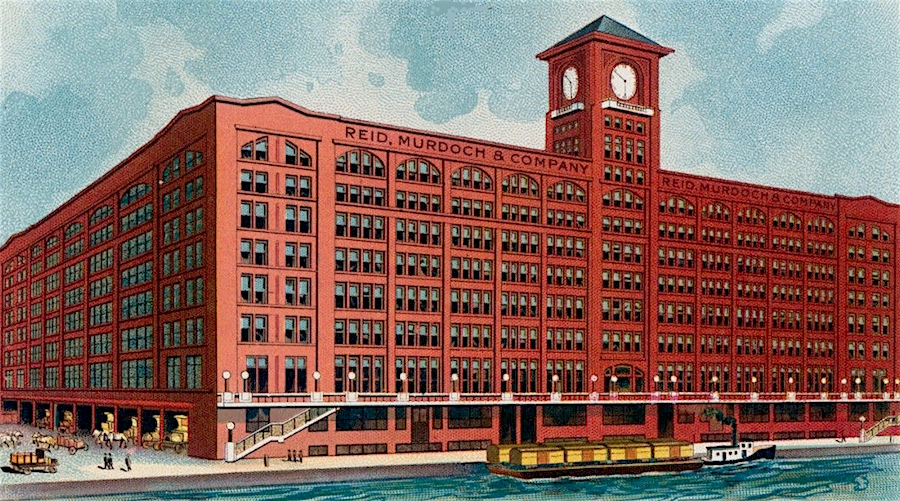
A Landmark House
The seven-story, 400,000 sq. ft. Reid-Murdoch Building was completed in 1913 and casts its shadow at 325 N. LaSalle Street, by the Clark Street Bridge. Designed by architect George C. Nimmons, the structure’s red-brick exterior and three-story clock tower still make it an immediate eye-catcher, but the real innovation 100 years ago was its orientation—facing toward the Chicago River rather than away from it. This had generally been avoided with most office buildings in the past, since the river was basically a swirling cesspool up until engineers reversed its flow at the turn of the century. Now, architects and business owners could actually utilize the waterfront as an aesthetic perk, with window views and promenades becoming the norm.
The view still wasn’t always guaranteed to be a pleasant one, however.
Less than a year after it opened, the Reid Murdoch Building provided the unfortunate backdrop for one of the worst shipwrecks in American history—the horrific S.S. Eastland Disaster on July 24, 1915—in which a tour boat picking up workers from the Western Electric Company capsized in the river, killing 844 people. Many of the dead and wounded were carried to the storage rooms of the new warehouse that day, as the normally pleasant aroma of coffee and cocoa provided a twisted sensory contrast. Ironically, most of the employees of Reid Murdoch were away on their own company outing that same day, so the rooms around the makeshift morgue were largely abandoned at the time, likely adding to the eerie morbidity of the scene.
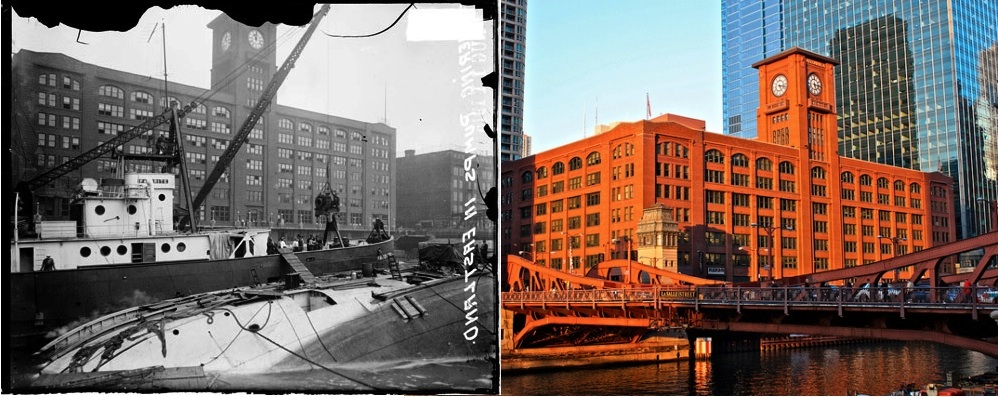 [The Reid Murdoch Building, during the SS Eastland Disaster in 1915 and present day]
[The Reid Murdoch Building, during the SS Eastland Disaster in 1915 and present day]
It’s a bit hard to pivot positively away from that subject matter, but on the bright side, the success of the building’s design really did play an important role in bringing Daniel Burnham’s famed Plan of Chicago to the riverfront—setting the tone for similar warehouses and providing a sprawling home for Reid, Murdoch, & Co. at its commercial peak. The warehouse itself underwent plenty of additions, subtractions and re-purposings over the years that followed, becoming government offices from the 1950s to the 1990s and the headquarters of Encyclopedia Britannica in the 2000s. Thanks to a designation as a historic landmark in 1976, though, it has always avoided the wrecking ball—unlike a lot of the other old warehouses and factories it once shared the river with.
Mr. Reid and Mr. Murdoch
So, how thrilled would company founders Simon Somerville Reid and Thomas Murdoch be to find out that their marvelous old headquarters was still standing? Well, the truth is, they never actually set foot inside the building themselves.
The two Scottish immigrants, both of whom hailed from small towns in the Highlands county of Moray, had shuffled off this mortal coil long before the first bricks were laid on the LaSalle Street structure. It’s still safe to say, however, that they’d built the metaphorical foundation for it.
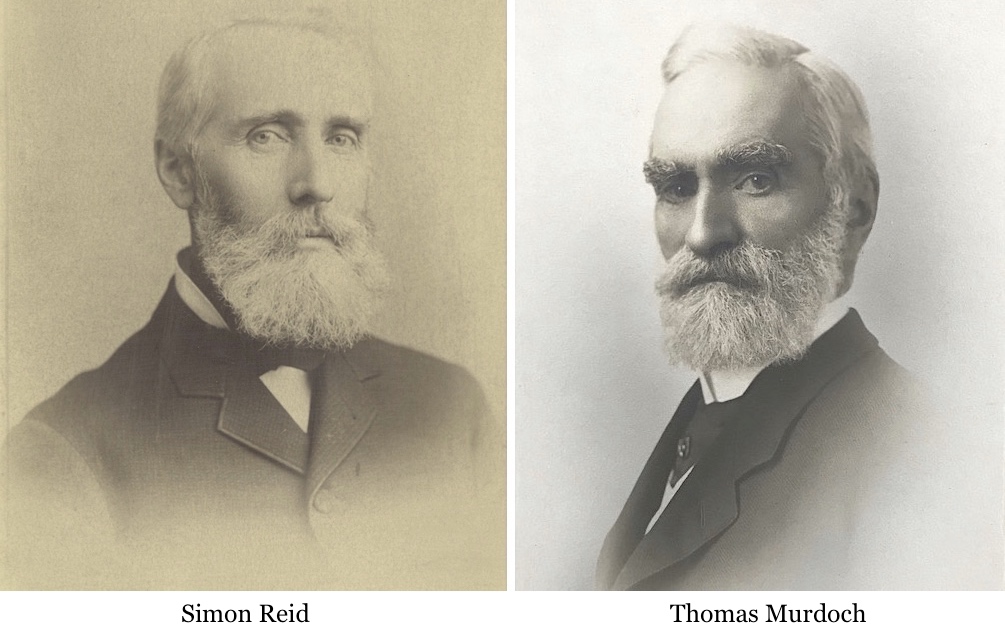
Simon Reid and Thomas Murdoch first crossed paths as young laddies fresh off the boat and looking for work in London, Ontario, in the early 1850s. They eventually joined forces, crossed the border into Buffalo, New York, and launched a produce and commission business that found some reasonable success. At this time, for any young ambitious merchants worth their salt in the U.S. of A., the next move was clear—head West, young man! In this case, that meant Dubuque, Iowa—a growing pit stop for wagon trains en route to the Oregon Trail.
And so, the original incarnation of Reid, Murdoch & Co. carried on as a frontier grocery operation from 1853 right up through the end of the Civil War in 1865. By then, it was decided that Chicago—with its railroads, river, and promising lack of catastrophic fires—would make a superior distribution center. So the two seasoned wholesalers picked up stakes, joined up with an experienced German grocer named Frederick Fischer, and started the firm of Reid, Murdoch & Fischer inside a four-story building at 40 River Street. They were now pioneers of a different sort, helping to define Chicago’s wholesale grocery industry in its formative years.
Ups and Downs
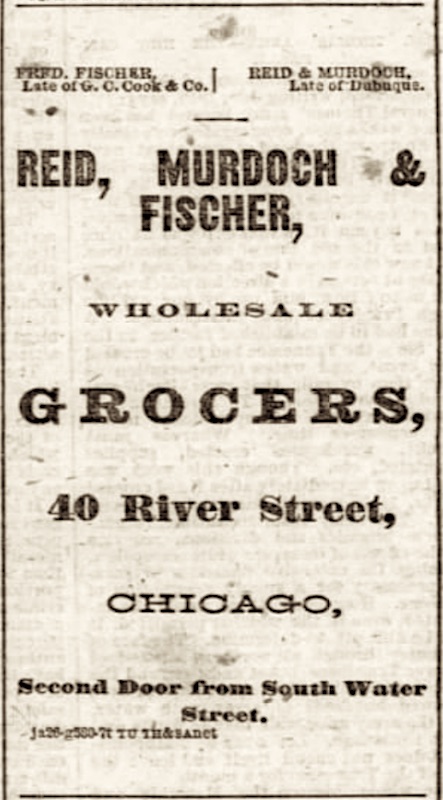 Of course, just a few years after Reid and Murdoch’s triumphant arrival, there was a bit of a snag. The Great Chicago Fire of 1871 destroyed basically everything they’d built. But no worries! Like any good golfing Scotsmen, they simply called it a mulligan and went right back to work, settling into new headquarters at Washington Street and Market Street, then 15-17 Randolph Street. Disasters be damned.
Of course, just a few years after Reid and Murdoch’s triumphant arrival, there was a bit of a snag. The Great Chicago Fire of 1871 destroyed basically everything they’d built. But no worries! Like any good golfing Scotsmen, they simply called it a mulligan and went right back to work, settling into new headquarters at Washington Street and Market Street, then 15-17 Randolph Street. Disasters be damned.
As most business owners of this period came to learn, though, disasters were pretty much par for the course in a cherubic metropolis still figuring out the science of structural integrity. In 1876, for example, that new five-story Randolph Street building proved a bit ill-equipped for Reid Murdoch’s over-stacked overstock, leading to a wee ceiling collapse. “About 40×50 feet of the two upper floors carried away,” the Tribune reported, “and the stock which was upon them dashed down through the lower floors into the basement and ground floors, leaving a mass of sugars, spices, coffees, dried and canned fruits—about one-fifth of the entire stock.”
Again, the boys merely dusted themselves off and continued to expand the business, moving into major warehouse spaces at 3-13 State Street and 86-100 Michigan Avenue through the 1880s and ‘90s, putting them in notoriously cramped shipping quarters with competitors like Sprague, Warner & Co. and Geo. W. Ludlow & Co. Besides selling their canned foods to Midwestern merchants, Reid-Murdoch also roasted its own coffee beans (which led to a few more building fires over the years), prepared its own brand of cigars, and employed teams of outside jobbers to peddle its goods across the country.
Meanwhile, in the warehouse itself, a team of more than 200 workers picked up and shipped out inventory, much of it coming in by wagons on a horribly log-jammed Michigan Avenue—then an industrial nightmare rather than a touristy one (Mayor Carter Harrison, Jr. would later praise Reid, Murdoch & Co. for developing a raised platform above the sidewalk to bring in its merchandise, while admonishing Sprague Warner for making the movement of traffic “practically impossible” by comparison).
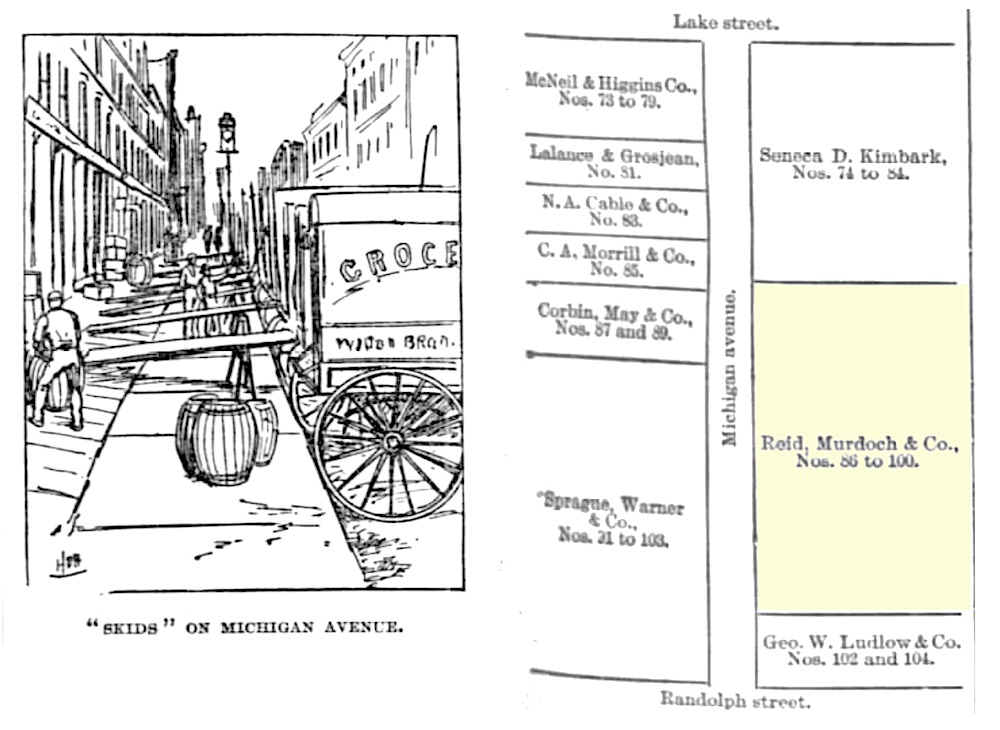 [The jam-packed wholesale warehouse scene along Michigan Avenue created daily headaches for City Hall. This drawing and diagram come from an 1890 issue of the Tribune]
[The jam-packed wholesale warehouse scene along Michigan Avenue created daily headaches for City Hall. This drawing and diagram come from an 1890 issue of the Tribune]
As was the norm for the era, some of Reid Murdoch’s workforce included children under the age of 16. Whatever moral quibbles this might generate from our modern sensibilities, though, it’s hard to say that Thomas Murdoch didn’t have the kids’ best interests in mind.
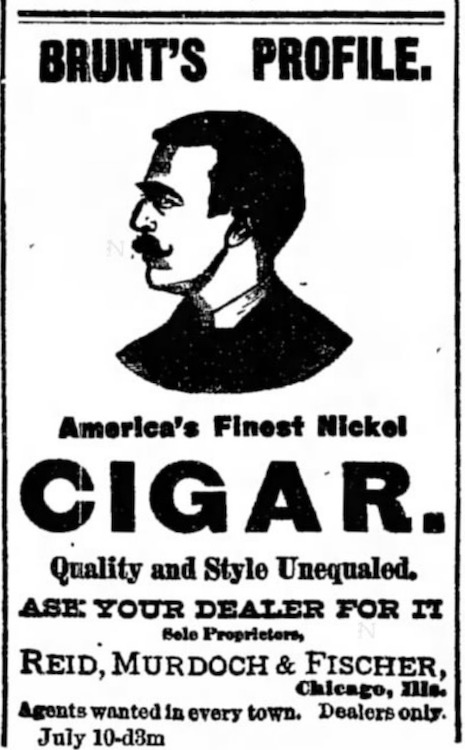 When a group of young boys, aged 13 to 16, were discharged from the company for repeated “petty pilfering” in 1882, the Tribune reported that “Mr. Murdoch said he had advised the parents of the boys to send them back to school and see if they could not put them in the right path. He wanted to see the boys get a chance again and hoped the newspapers would make no reference to the matter. If the parties had been men they would have been prosecuted, but, being such young boys, he thought an arrest would have ruined them.”
When a group of young boys, aged 13 to 16, were discharged from the company for repeated “petty pilfering” in 1882, the Tribune reported that “Mr. Murdoch said he had advised the parents of the boys to send them back to school and see if they could not put them in the right path. He wanted to see the boys get a chance again and hoped the newspapers would make no reference to the matter. If the parties had been men they would have been prosecuted, but, being such young boys, he thought an arrest would have ruined them.”
Years later, Murdoch’s friend and fellow industrialist John Glessner (International Harvester) remembered him as “a man of quick, sure, and wise decision.”
Simon Reid seemed to be a reasonable fellow, as well. Upon his untimely death in 1892, Chicago’s Inter Ocean reported that “No citizen of Chicago has been more respected by the business community or more beloved by his friends. . . . Mr. Reid was so quiet and unassuming in the midst of his large wealth that only his friends knew his full worth, but everyone who ever saw him must have been impressed by his benignity and courtesy. . . . His business reputation for honesty, for clear judgment, for safe and wise counsels, was a most enviable one, and no house in Chicago has a surer foundation that Reid, Murdoch & Co.”
Reid’s death came four years after the retirement of Fred Fischer, leaving Thomas Murdoch as the surviving founder and company president as the business transitioned into a new century.
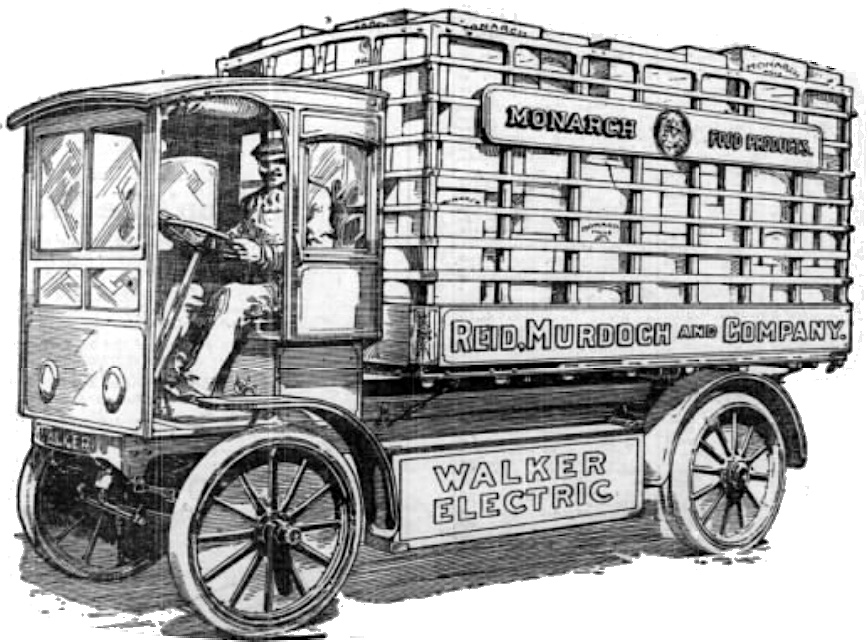
A Chicago Institution
In 1899, a massive new Reid Murdoch warehouse was completed at the corner of Lake Street & Market Street (now Wacker Drive), on the location where the famed “Wigwam” once stood—the convention center in which Abe Lincoln earned the Republican nomination in 1860.
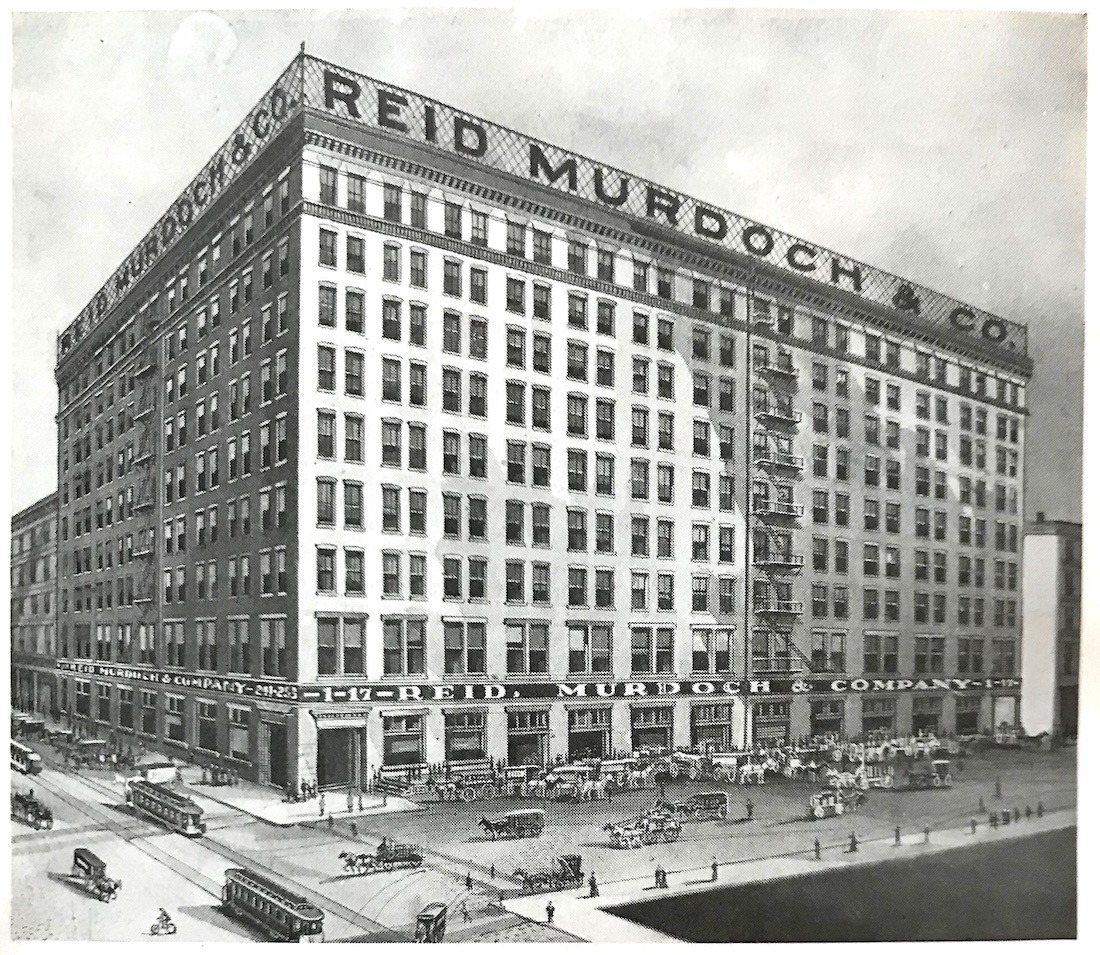 Columnist Frank H. Spearman of the Sunday Times-Herald wrote just before the opening that “The Wigman itself has long ago gone the way of all flesh . . . But today the spot can boast one of the most completely modern ten-story fireproof structures to be found anywhere in this country. It is the new home of Reid, Murdoch & Co.”
Columnist Frank H. Spearman of the Sunday Times-Herald wrote just before the opening that “The Wigman itself has long ago gone the way of all flesh . . . But today the spot can boast one of the most completely modern ten-story fireproof structures to be found anywhere in this country. It is the new home of Reid, Murdoch & Co.”
The 260,000 sq. ft. structure was the largest of its kind in the world, and while it would only serve as Reid-Murdoch’s HQ from 1899-1914, it found the business in a bit of a crazy transitional period. In later years, Reid-Murdoch would have more than a dozen major canning, manufacturing, and distribution facilities across the country, from Boston to L.A. But at the turn of the century, a good chunk of the entire business was still centered right there in Chicago, with a team of 389 employees—including 13 children and 92 women—keeping the Reid Murdoch machine moving.
“The word ‘plant’ comes nearer defining a great modern wholesale grocery house than any other expression,” Spearman wrote. “Such an establishment is not merely a store; it is a warehouse; and not alone a warehouse, but a factory. Under this one capacious roof, besides all the features of a jobbing business of more than ordinary proportions, there will be a coffee and spice mill plant, a mammoth cold storage plant, a big syrup refinery, a canning and preserving factory—and each of proportions which dwarfs the average institution professing to make a specialty of any one of those branches.
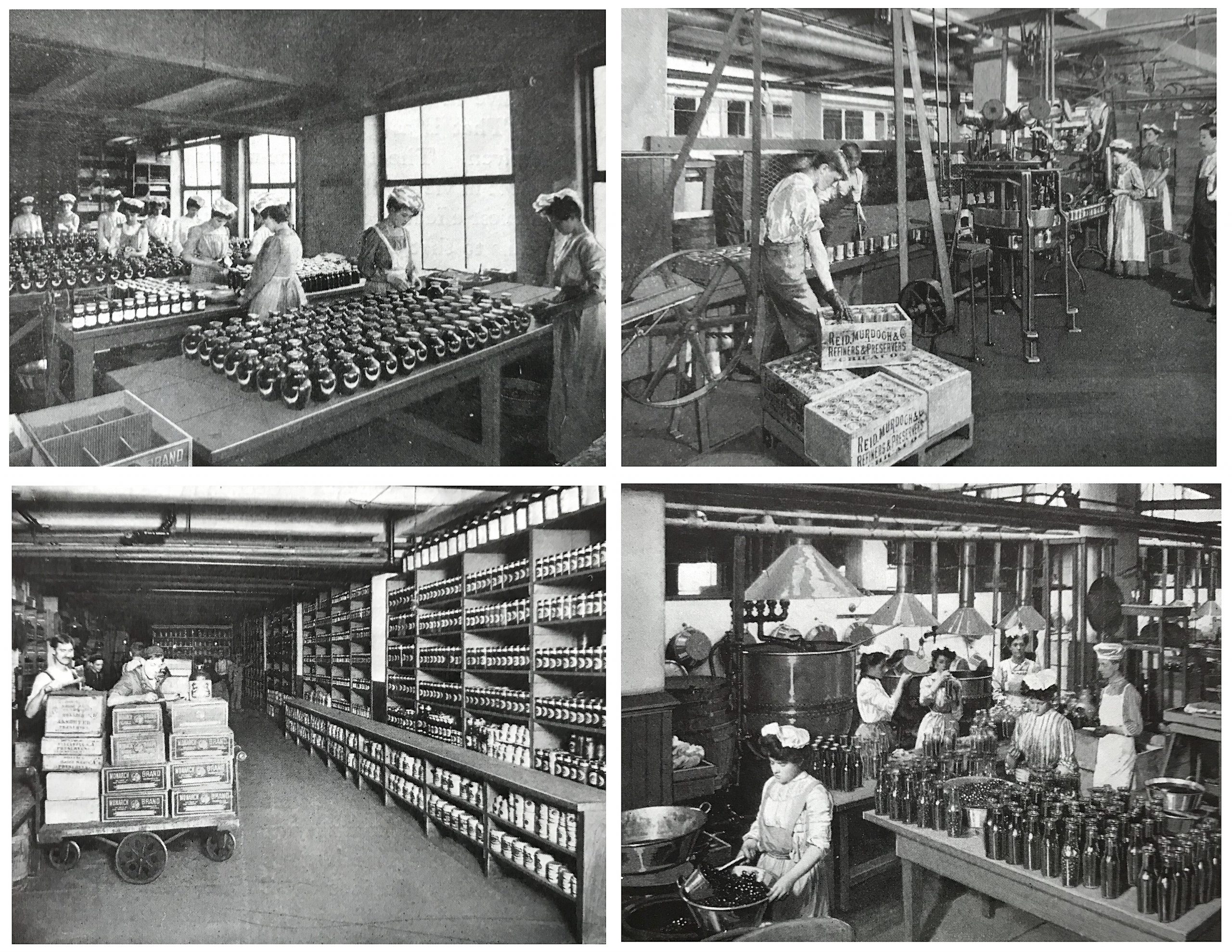 [Workers inside the Reid Murdoch factory in 1903. Top Left: Putting the labels on Monarch preserves. Top Right: A machine for filling, sealing, and labeling 18,000 cans a day. Bottom Left: A corner in the shipping department. Bottom Right: Packing of Monarch maraschino cherries.]
[Workers inside the Reid Murdoch factory in 1903. Top Left: Putting the labels on Monarch preserves. Top Right: A machine for filling, sealing, and labeling 18,000 cans a day. Bottom Left: A corner in the shipping department. Bottom Right: Packing of Monarch maraschino cherries.]
“The output of a business so enormous as that of Reid, Murdoch & Co. staggers belief. . . . In addition to all their own manufacturing they draw constantly on the manufacturers and producers of the world for their supplies. They contract for the fruit of the olive groves of Spain, and for the leaf of the tea gardens of India. They compete with the Russians for the fine Oolongs of China, and their buyers scour France for the delicacies which are made to tempt the palates of the aristocrat of Europe. Their competition harries the London spice merchant in Singapore, and in Java and Sumatra they forestall the thrifty Dutchman of Amsterdam by contracting the crops of the choicest coffee plantations even before the berry is formed under the blossom.
“In a word, the methods are Chicago methods, their ideals Chicago ideals, and only Chicago could have made possible so marvelous a growth from so modest a beginning.”
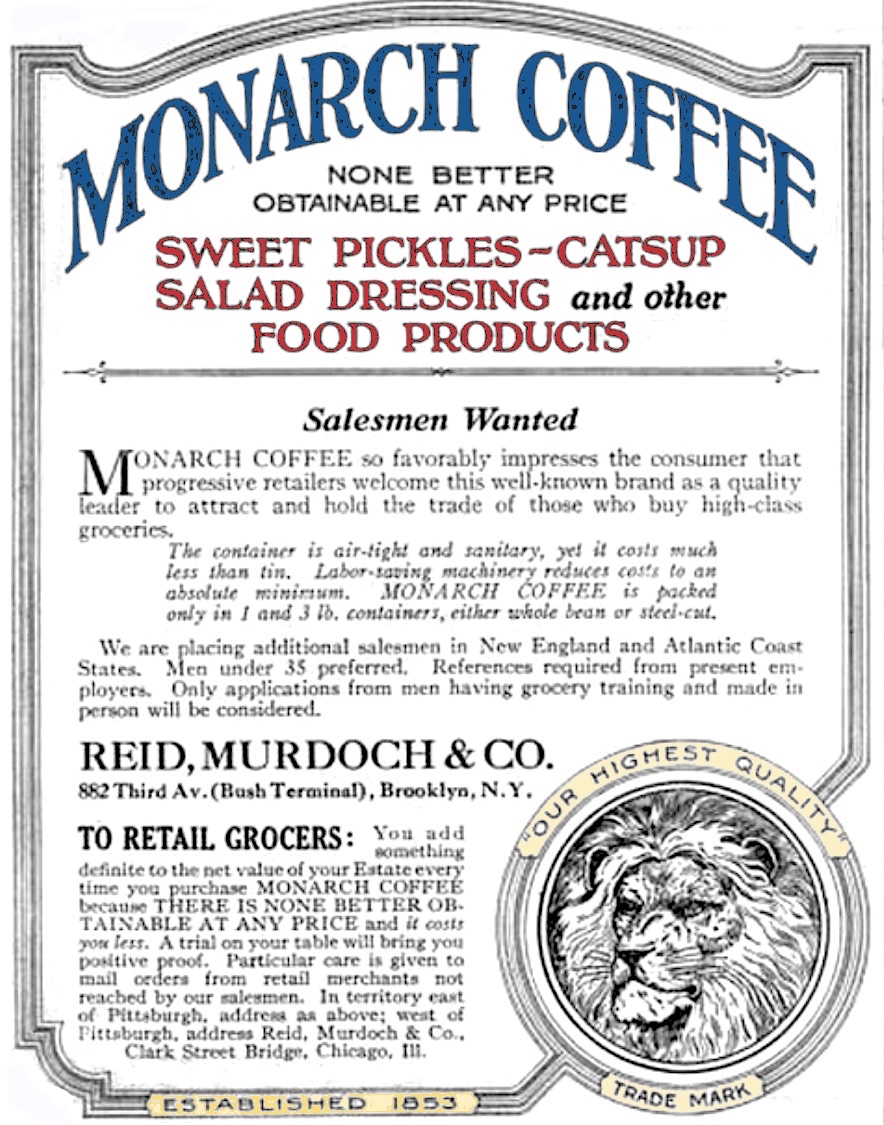
A Louis Named Jack
If the Reid-Murdoch story was only possible in Chicago, the same would logically apply to many of the men and women who made a career with the firm.
According to a letter written by company vice president J.J. Dau in 1899, not a single one of Reid Murdoch’s 400-odd workers had a college education. It was just another aspect of those Chicago methods.
“As far as expedient,” Dau wrote, “we begin with boys at the age of sixteen and train them gradually to the field for which they show most efficiency. When employing a person later in life, it is naturally for certain duties in which he must have acquired training and experience elsewhere; but even then, and with all due respect, we obtain better results three times out of four from a man who has gained his knowledge in our own house.”
And perhaps no man followed that track to greater success than Louis Sidney Anderson—better known to his friends as “Jack,” for reasons long since forgotten.
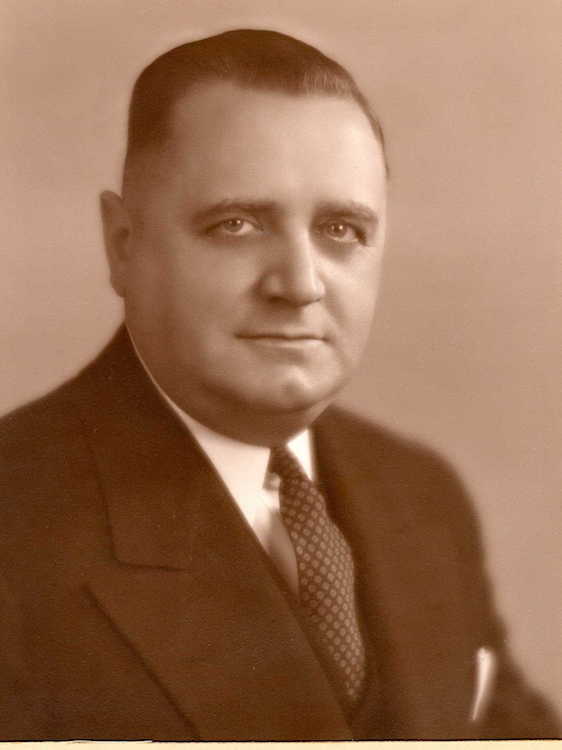
In 1911, two years after Thomas Murdoch’s death, young Mr. Anderson—barely 17—got his first job with the big wholesaler, working as a low-level clerk, according to a snippet later printed in the 1942 edition of Who’s Who in Chicago. From there, Jack spent two decades working his way all the way up to the role of Executive Vice President, leading Reid-Murdoch through the Depression and World War II. His remarkable origin story, shared with the Made In Chicago Museum by his own granddaughter Cathy Cline, is really a classic folk tale of the industrial age.
“My grandfather actually started out at Reid Murdoch as more of a janitor, rather than a clerk,” Cathy tell us. “The Who’s Who bio is generous in using that term.
“He left school in 6th grade because his father was ill and his help was needed on the family farm [in Wisconsin]—they raised horses. Jack’s entertainment as a boy was riding the unbroken yearlings with his brothers—a big no-no but they did it anyway. After his father died when Jack was nine, his mother remarried quickly to a widower who never had any children. Needless to say, the new step-father was not well equipped to deal with a big rowdy Norwegian family [Jack’s parents were Norwegian immigrants and he grew up bilingual]. Jack left home at 16 due to conflict with his step-father and went straight to the big city of Chicago.
“He actually found his first job at a warehouse on the Chicago River next door to Reid Murdoch. He was a tall, muscular and handsome Norwegian farm lad [5’11” actually, but that was tall back then], so he caught the eye of the young woman who was in charge of assigning jobs at the warehouse. Unfortunately, her boyfriend, who also worked at the warehouse, didn’t much care for that and picked a fight with Jack. Bad idea. Jack was the youngest of four brothers and fresh off the farm, and he won the fight in seconds. The boyfriend took much longer than that to regain consciousness. [photo below: Louis “Jack” Anderson at a sales conference, circa 1915]
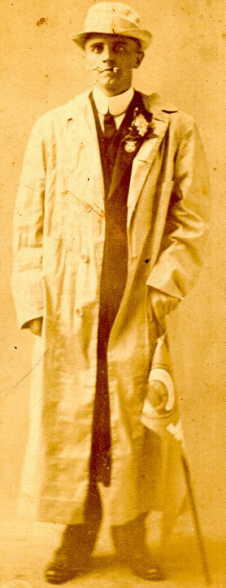 “In the aftermath, the foreman was not very understanding and promptly fired Jack, along with the young woman and her beau. All this transpired before noon, so Jack held that job only a few hours! Unconcerned, he simply walked down the street to the next warehouse, which just so happened to be the Reid Murdoch building [the Wigwam location at Lake and Market Street].
“In the aftermath, the foreman was not very understanding and promptly fired Jack, along with the young woman and her beau. All this transpired before noon, so Jack held that job only a few hours! Unconcerned, he simply walked down the street to the next warehouse, which just so happened to be the Reid Murdoch building [the Wigwam location at Lake and Market Street].
“The warehouse was under the headquarters and ran the entire length of the building. The trains came directly into it and were unloaded and loaded out of the weather. Jack was hired to sweep out the warehouse—the entirety of it—every day.
“His was a true American rags to riches story. He was the son of immigrants and an orphan by the time he was 17, after his mother died unexpectedly. He literally started out at the bottom and, with only a 6th grade education and absolutely no support from anyone, worked his way up to executive vice-president, which today would be called CEO. Through it all, my grandfather remained a down to earth, unassuming, humorous, and loving person.”
Getting that all-important in-house education, Louis S. “Jack” Anderson really did go from sweeping floors to selling Monarch goods by the age of 19, and when new company president Frank H. Armstrong officially moved Reid-Murdoch into its LaSalle Street headquarters in 1914, Jack was part of its inaugural sales staff. Though he spent many years on the road as a traveling salesman, Jack was likely there to see the heartbreaking clean-up after the Eastland Disaster in 1915, and he also faced the uncertainty many of his fellow workers shared after registering for military service during World War I.
By 1922, Anderson was promoted to the role of sales manager by new president Horace Armstrong (son of the late Frank), and he became a key figure as Reid Murdoch made a couple major shake-ups to its business model. First, the company discontinued its jobbing lines to focus solely on food products. Second, they broke away from an outdated anti-advertising policy to start actually promoting their coffees and cocoas in commercial newspapers and magazines, rather than exclusively via salesmen [previously, all salesmen had been told to tell customers that those pesky ad dollars had all been put into the quality of the coffee, etc.].

The business magazine Sales Management made a point of mocking Reid-Murdoch’s long overdue entry into modern advertising in 1922 with a bit of dry wit in its reporting:
“Some months ago Reid-Murdoch started advertising. First they advertised for salesmen. Then, little by little, they gradually began to drag in a few words of praise for their coffee. We consoled ourselves with the idea that of course the great house of Reid-Murdoch had not stooped to advertising. We thought they were simply telling how good their coffee was, simply to let the prospective salesmen know what sort of a product they were being solicited to sell.
“But now we must be forced to the conclusion that modern grocers gave Reid-Murdoch salesmen the horse-laugh when they openly boasted of the non-advertising policy. Anyhow, something must have happened, for Reid-Murdoch are now brazenly advertising—in full color pages. We hope they didn’t forget anything in their advertising. They list forty products, print pictures of nineteen cartons, offer a free booklet, show three arrows with colored feathers, a picture of the plant, and a lion’s head.”
Turns out the advertising thing worked pretty well, and when Louis S. Anderson was elected vice president in 1929, he committed the company to more of it. This included a successful campaign throughout the 1930s known as “The Monarch Way—See It in Glass, Buy It in Tin.” The idea was to help retailers set up better Monarch merchandise displays while gaining greater trust from the buying public. Toward that end, Reid-Murdoch started using glass jars to create transparent display versions of each one of their tin-can food products. That way, customers could actually see what Monarch foods looked like, with their own eyes, before they bought a can of the stuff. It was a bold, honest marketing move that seemed to resonate with grocery buyers during the Depression.
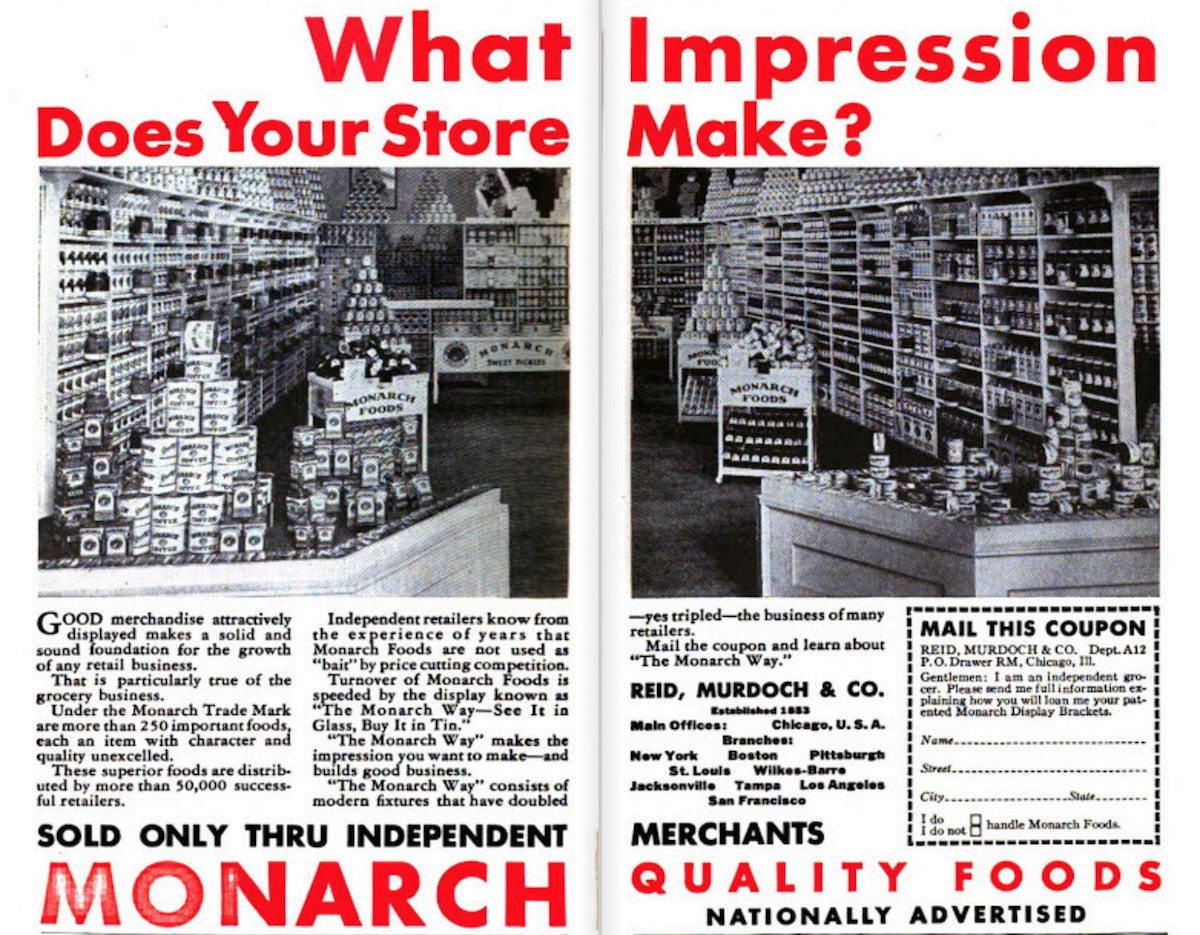
[Above: Trade Advertisement for “The Monarch Way,” 1930. Below: Three Monarch spice tins from our museum collection, dating from around the same period: Whole Cloves, Ground Allspice, and Ground Nutmeg]
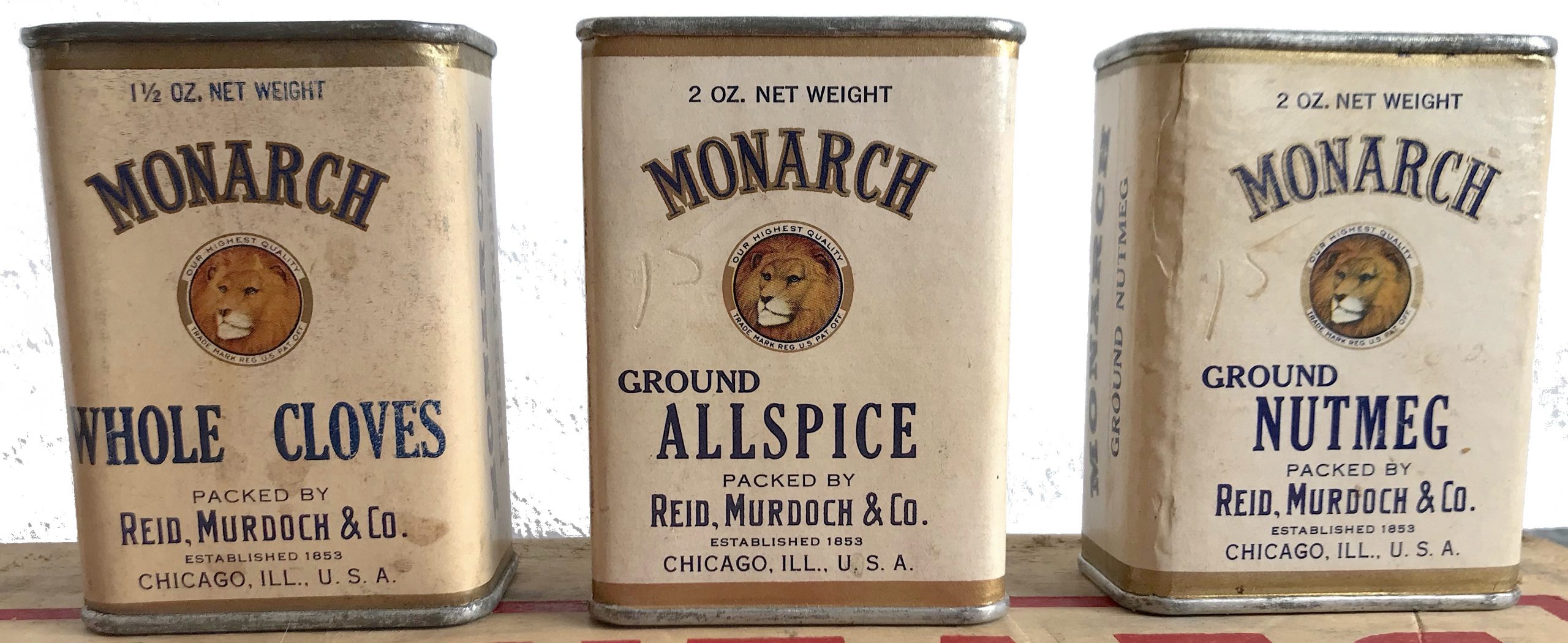
Final Years
In the end, Reid Murdoch actually survived both the Depression and the challenges of World War II rationing still in tact. But they were rapidly losing their market share as the chain store era loomed. In 1945, Louis “Jack” Anderson and his fellow board members made the tough call to sell the longtime independent firm—in the midst of its 80th anniversary in Chicago—to Nathan Cummings’s modern super-conglomerate Consolidated Foods, Inc., which also now owned Reid-Murdoch’s old rivals Sprague, Warner & Co.
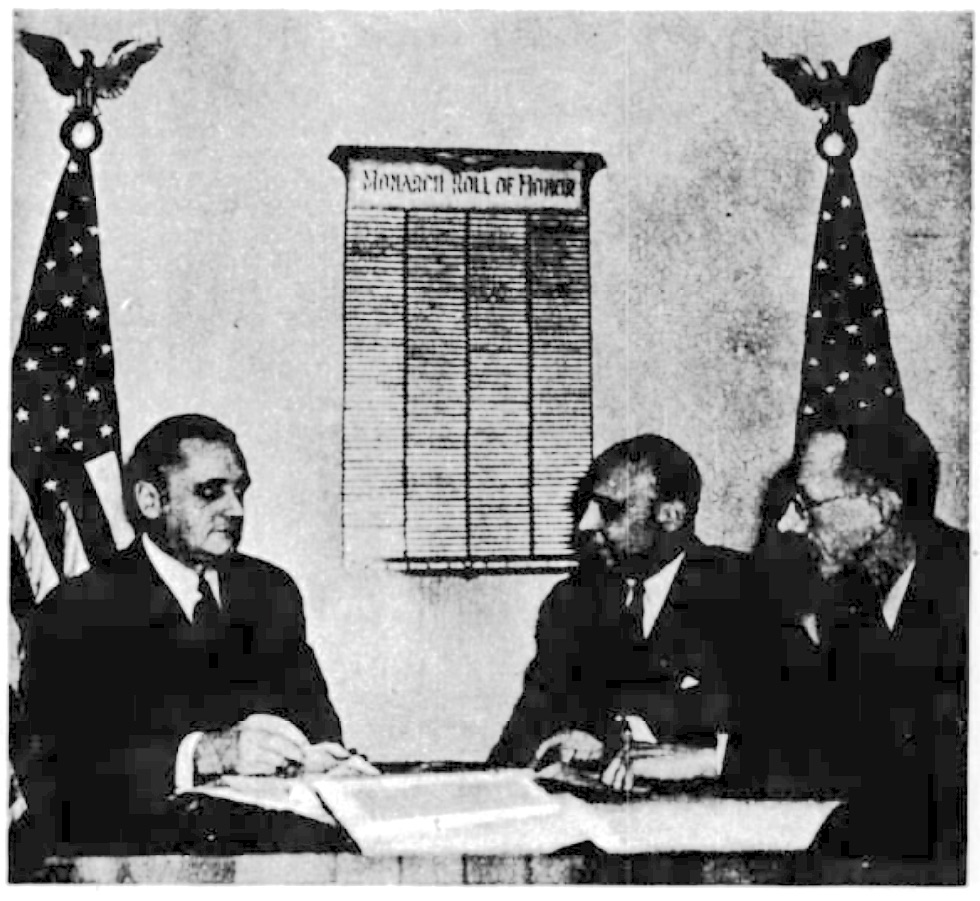 [Louis S. Anderson (left) meets with his advertising manager R.B. Newton (far right) and Chicago Tribune ad buyer L.W. Jacobsen in April of 1943. Behind them is a plaque honoring 214 Reid-Murdoch employees in service in WWII]
[Louis S. Anderson (left) meets with his advertising manager R.B. Newton (far right) and Chicago Tribune ad buyer L.W. Jacobsen in April of 1943. Behind them is a plaque honoring 214 Reid-Murdoch employees in service in WWII]
Anderson, who was 53 at the time of the company’s sale, was retained as executive vice president, but retired within months of the deal, citing a lingering illness. He died in Florida in 1950.
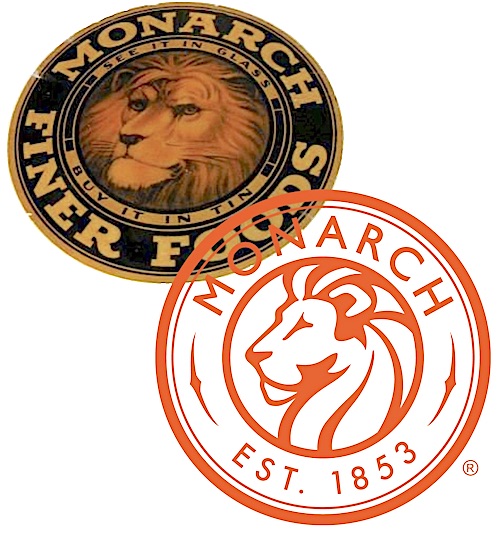 Meanwhile, Consolidated Foods went about the business of integrating Reid Murdoch’s old operation completely and thoroughly into its own network. By 1953, the Reid Murdoch name itself was quietly scrapped, as the “Monarch Finer Foods Division” took its place. Many of Reid-Murdoch’s facilities around the U.S. remained in use, but the Reid Murdoch Building in Chicago was sold to the city in 1954, housing traffic courts, among other things.
Meanwhile, Consolidated Foods went about the business of integrating Reid Murdoch’s old operation completely and thoroughly into its own network. By 1953, the Reid Murdoch name itself was quietly scrapped, as the “Monarch Finer Foods Division” took its place. Many of Reid-Murdoch’s facilities around the U.S. remained in use, but the Reid Murdoch Building in Chicago was sold to the city in 1954, housing traffic courts, among other things.
The Monarch name has remained in use up to the present day, under the ownership of several different giant foodservice distributors; most recently US Foods, which is based in Rosemont, IL. The lion head logo, sometimes claimed to be the oldest commercial trademark in use in the country, has actually evolved quite a bit, but it’s still intended to communicate the same message. “The Monarch lion,” according to the current US Foods corporate website, “stands as a symbol of trust and integrity, and a promise of quality, convenient and value-driven pantry staples.”
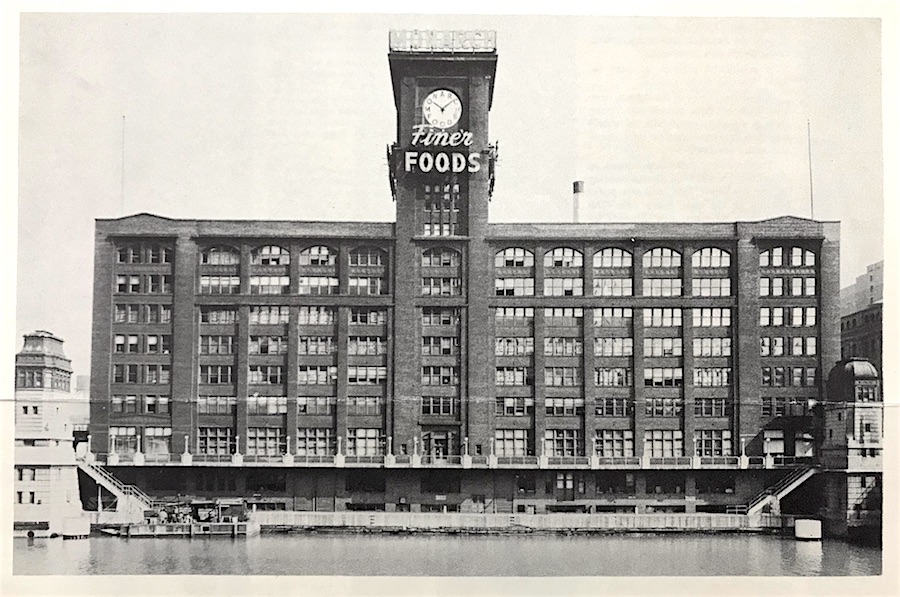 [A look at the Reid Murdoch Building in 1954, just after the Monarch Finer Foods Division abandoned it for good]
[A look at the Reid Murdoch Building in 1954, just after the Monarch Finer Foods Division abandoned it for good]
Sizing Up Our Artifact
Because of the massive number of cans and bottles that Reid, Murdoch & Co. sent out into the world during its prime 20th century years, many lion-head artifacts like our 16 oz. Monarch Cocoa tin are fairly easy to find out on the collector’s market. In the 1920s, Reid-Murdoch actually promoted its cheaper American-style “Farm House” cocoa mix a little more than the Dutch-process Monarch Cocoa, but the latter seems to be available in greater supply these days.
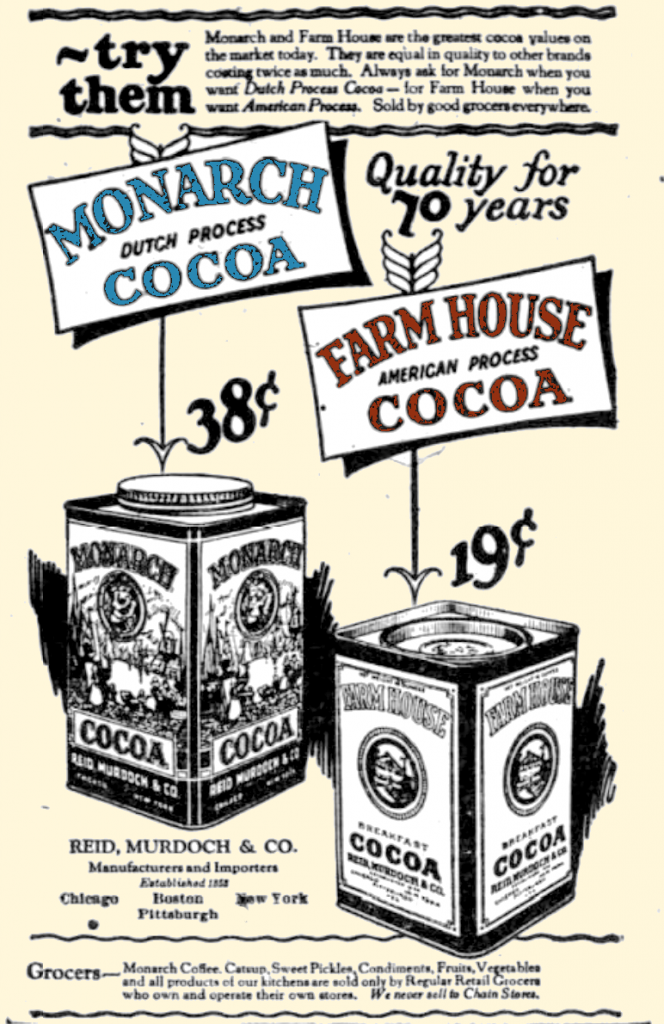 That being said, not all versions of the Monarch Cocoa tin are alike. Most examples of the flat-top tin still in circulation feature the name of a different Reid Murdoch satellite warehouse location at the bottom of each panel—New York, Los Angeles, Pittsburgh, and Boston—along with a special anniversary lid with the words “Quality for 70 Years.” These would date from at least 1923 onward. The tin in our collection, however, lists only “Chicago, ILL” on all four sides, with “Monarch Finer Foods” on the lid, perhaps dating it closer to the 1910s or very early ’20s. It’s much harder to find this Chicago-centric version, but it may or may not actually be of greater value.
That being said, not all versions of the Monarch Cocoa tin are alike. Most examples of the flat-top tin still in circulation feature the name of a different Reid Murdoch satellite warehouse location at the bottom of each panel—New York, Los Angeles, Pittsburgh, and Boston—along with a special anniversary lid with the words “Quality for 70 Years.” These would date from at least 1923 onward. The tin in our collection, however, lists only “Chicago, ILL” on all four sides, with “Monarch Finer Foods” on the lid, perhaps dating it closer to the 1910s or very early ’20s. It’s much harder to find this Chicago-centric version, but it may or may not actually be of greater value.
As for how the cocoa actually tasted? Well, our tin is sadly empty, so I’m afraid I can’t really tell you how Monarch might have stacked up vs. your basic Hershey’s, Cadbury, or Nestle Quick mixes. If anyone does have any memories of a wintery day and a cup of cocoa from the old lion-head tin, though, do let us know.
Also, if you’re a gravestone hunter, you can find the final resting places of both Thomas Murdoch and his old pal Simon Reid at Lake Forest Cemetery.
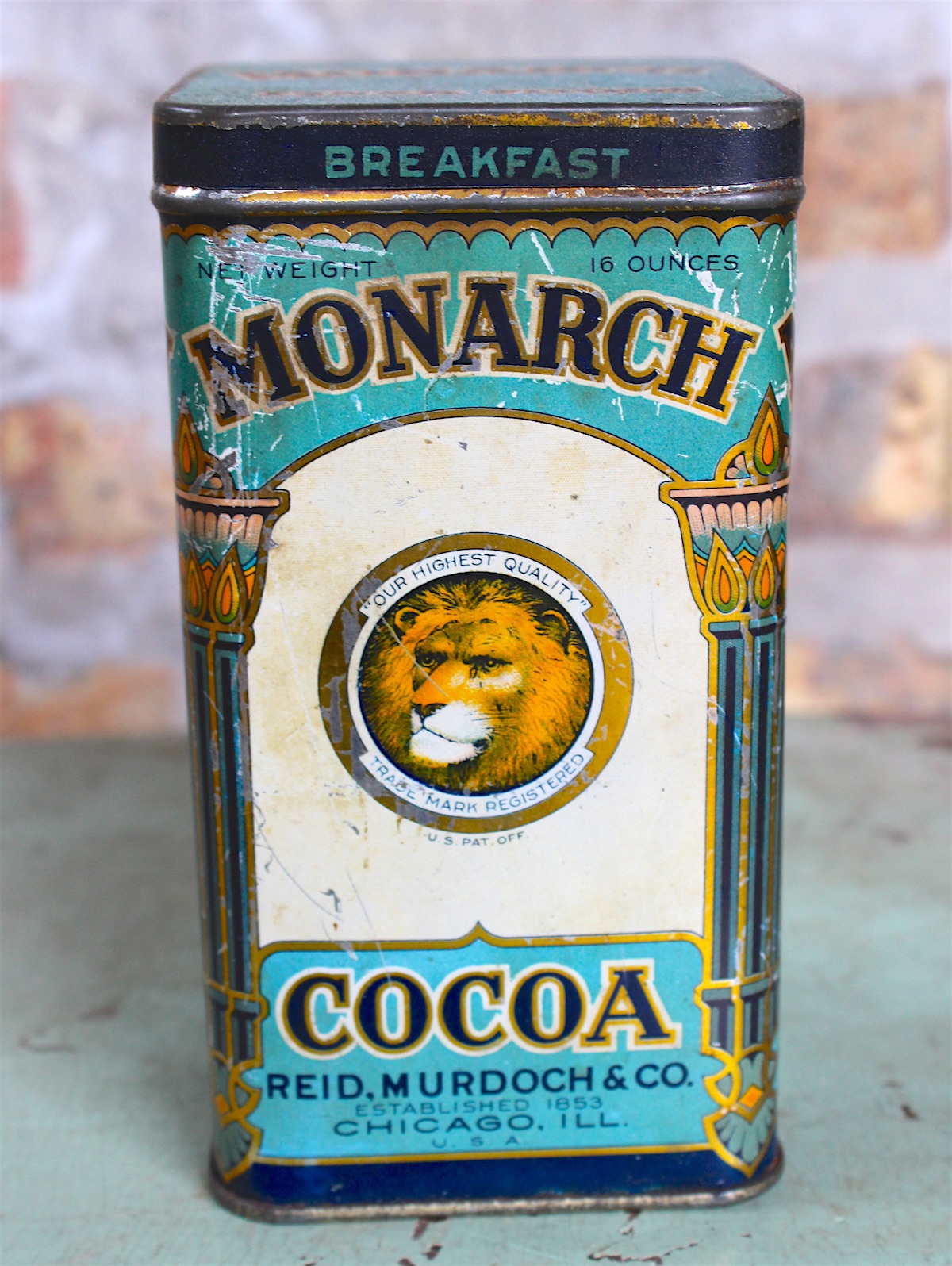
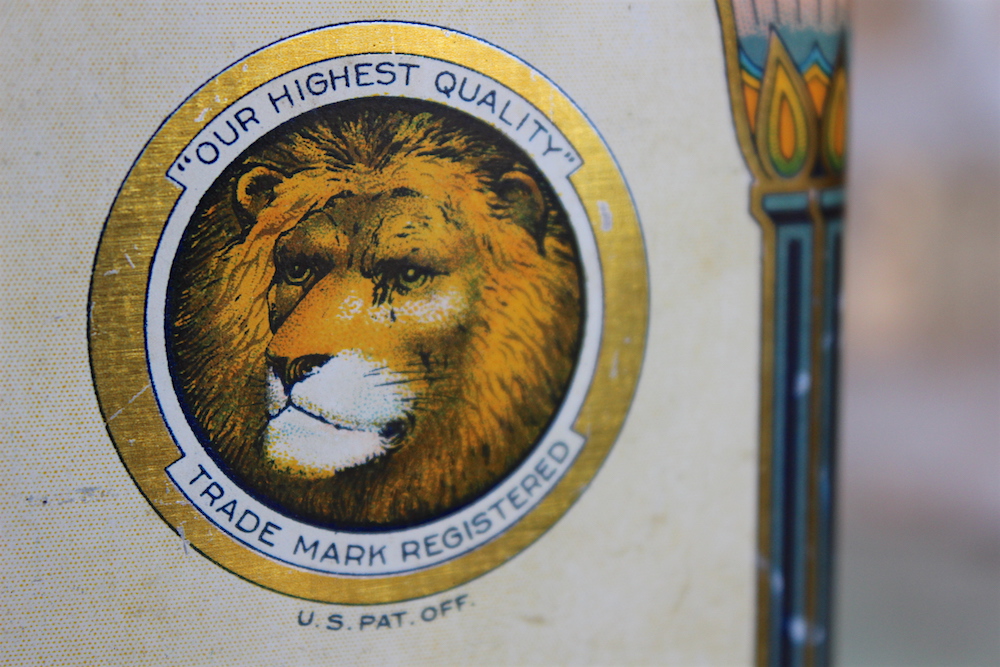
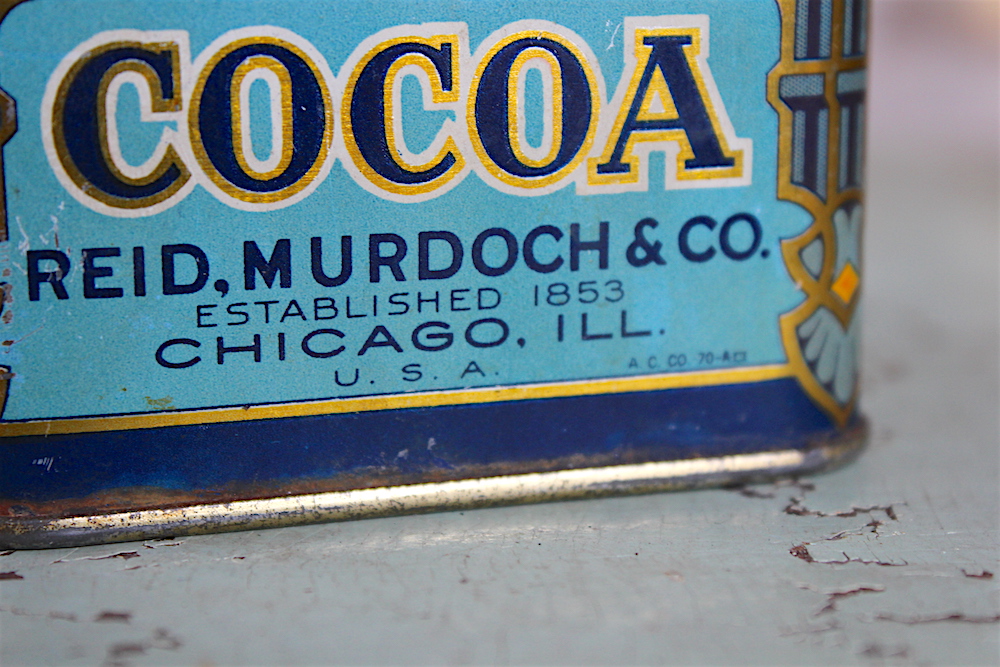
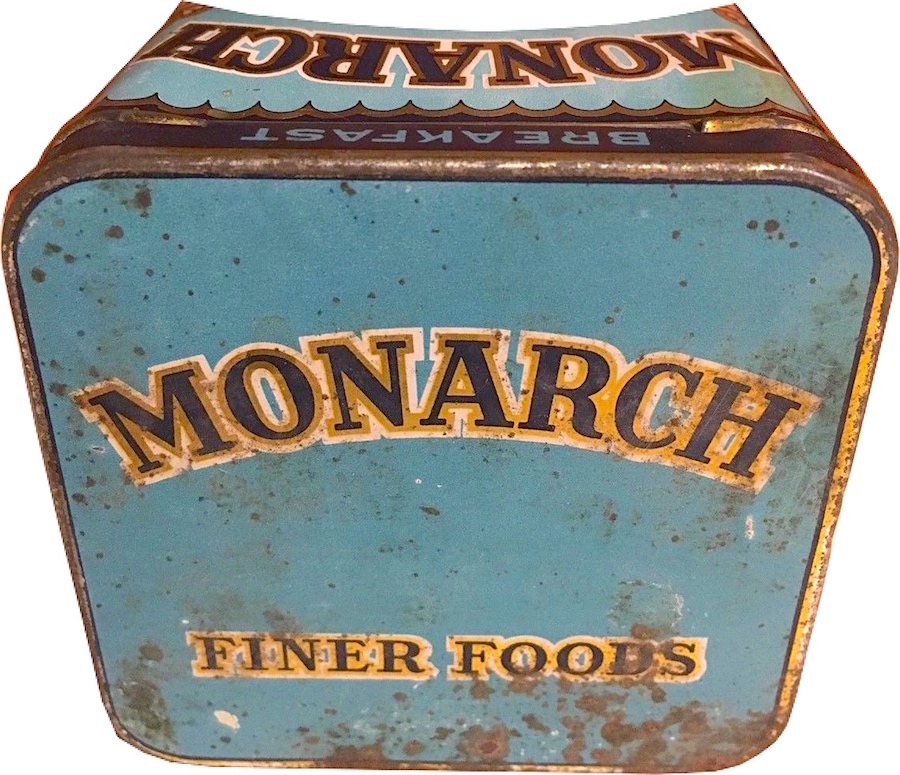
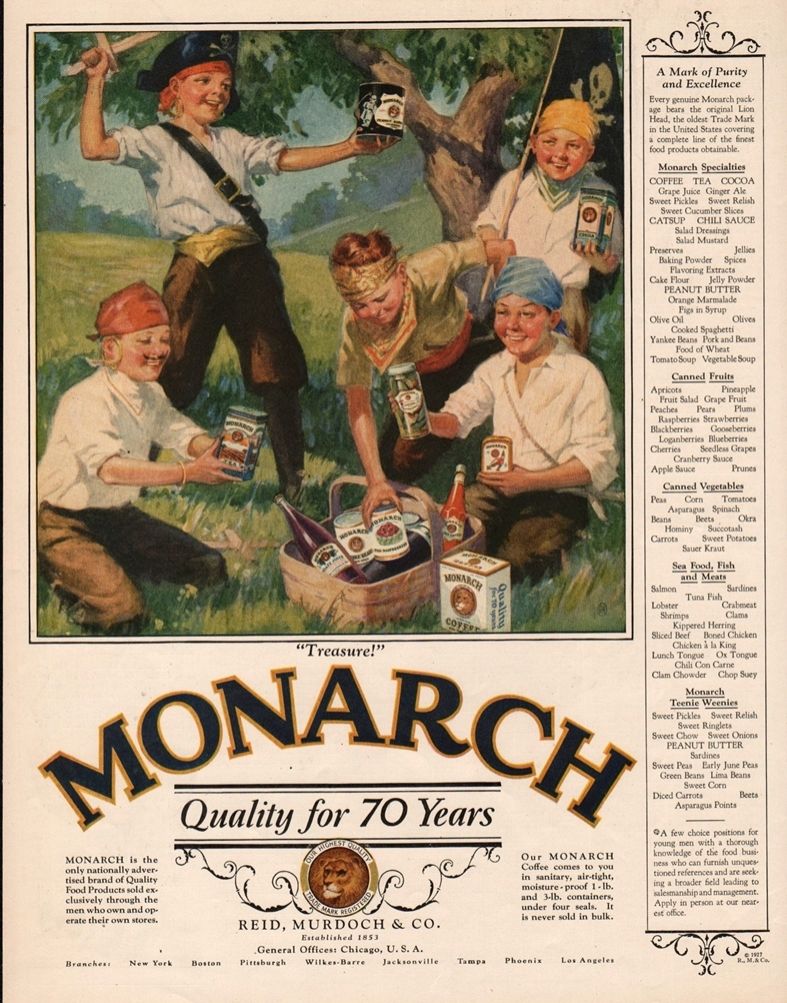
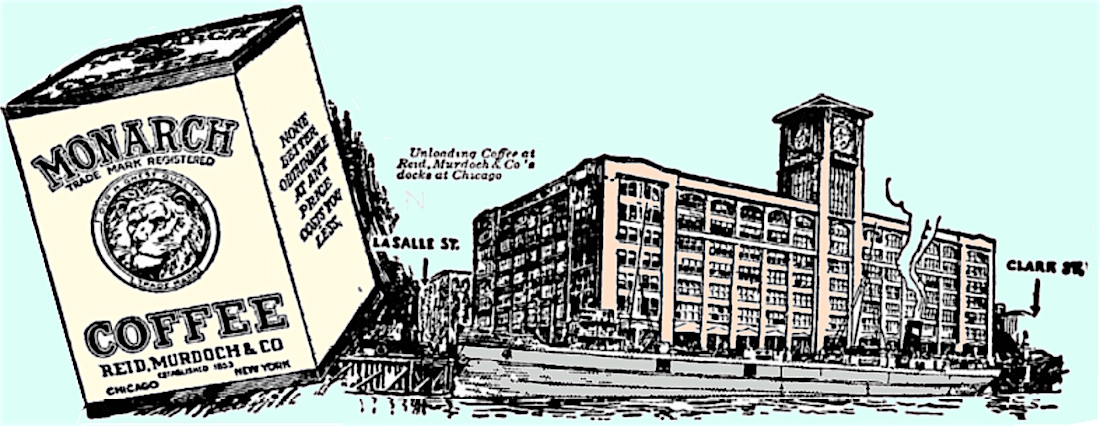
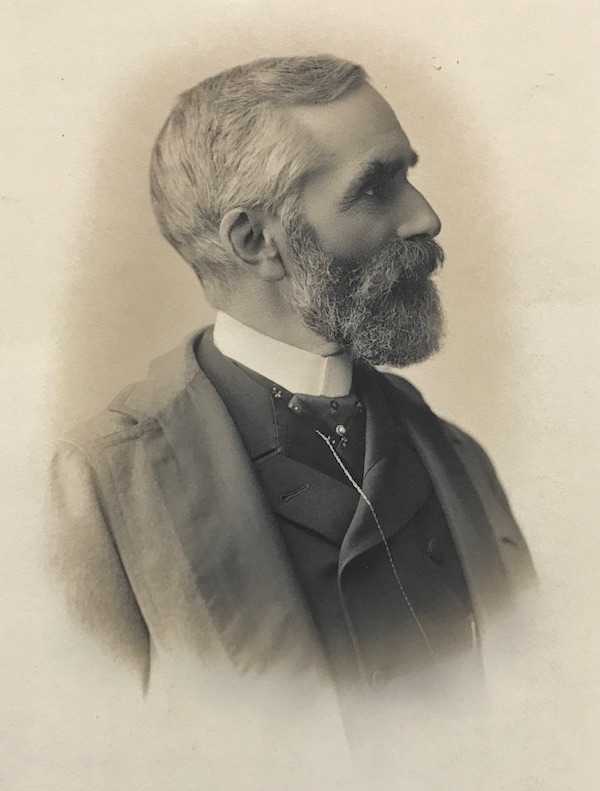 [Thomas Murdoch, a life-long bachelor, was described by friend John Glessner as “a man of quick, sure, and wise decision. Unlike John Crerar, he had a beautiful home, presided over graciously by his two sisters. He was a keen sportsman with the rod, owned the fishing rights for miles on both sides of the Canadian river York, and not only enjoyed this contemplative men’s recreation, but delighted to take friends, and some quite young men among them, to camp or march or sail with him. He, too, dying, left a large estate to charities selected with much thought and care.”]
[Thomas Murdoch, a life-long bachelor, was described by friend John Glessner as “a man of quick, sure, and wise decision. Unlike John Crerar, he had a beautiful home, presided over graciously by his two sisters. He was a keen sportsman with the rod, owned the fishing rights for miles on both sides of the Canadian river York, and not only enjoyed this contemplative men’s recreation, but delighted to take friends, and some quite young men among them, to camp or march or sail with him. He, too, dying, left a large estate to charities selected with much thought and care.”]
Sources:
“Reid, Murdoch, Sprague Join In Big Food Firm” – Chicago Tribune, May 29., 1945
“Monarch Story Goes Back to 1853” – Chicago Tribune, February 16, 1955
Eastland Disaster Historical Society
“A Perfect Day for a Cruise” – Scots Great and Small, People and Places
“Another Non Advertiser About Faces” – Sales Management, Vol. 5, October, 1922
“Reid, Murdoch & Co” – Illinois: A History In Pictures, by Gerald Danzer, 2011
Should Auld Acquaintance Be Forgot, by John Jacob Glessner, 1924
“Reid Murdoch Building” – National Park Service
“Pioneer Grocer of Chicago Is Dead” – Chicago Tribune, December 26, 1909
“Simon Reid Laid to Rest” – The Inter Ocean, Feb 17, 1892
“See It In Glass, Buy It In Tin” – The American Exporter, Vol. 102, March 1928
“Decline in Goods: Accident on Randolph Street” – Chicago Tribune, June 28, 1876
“Historic Ground: Reid, Murdoch & Co. Will Occupy Famous Wigwam Site” – Sunday Times-Herald, March 26, 1899
“Mr. J.J. Dau” – Going to College, by Waitman Barbe, 1899
Archived Reader Comments:
“Thomas Murdoch was my husband’s Great (Several Times) Uncle. He is a decendant of Thomas’s brother who migrated to Australia.” —Margaret French, 2019

I have a very old bottle – it’s green with a huge dent in the bottom and a stamped pernod fils the label says old orchard brand pure cider vinegar reid, mudoch and co distributors chicago
Thomas Murdoch was my great, great, great uncle. He left around half his fortune to his nieces and nephews around the world and my great grandmother Eva Murdoch and her sisters used some of their money to travel around the world in 1912. She then built a beautiful federation style farmhouse in the eastern wheatbelt of Western Australia. My Dad grew up there.
Recently found out my great grandfather was the foreman for reid- murdoch and retired in 1931. However from what I gather the plant was located in Hammond,IN.
I recently bought a full page, color magazine ad for Monarch Sweet Peas from 1949. I’m wondering if anyone knows the artist the company used.
i recently came across a pickle crock with a beveled base to fit atop another crock (for ice?). how can i date this piece? thank you for your time in this.
best regards,
george forsberg
Where can I find lids for the lion embossed jars ?
I remember drinking Monarch instant tea in the early 1990’s in Canada. I never knew much about Monarch brand but I liked it’s lion label. The instant tea came in a cardboard type tin container with a lid. About the size of a peanut container. I can’t any info on this product online.
The Monarch “Lion” trademark was registered in many countries and marketed through agents and distributors. Consolidated Foods sold the international rights to National Can Corporation which incorporated it into the newly formed NCC Food Corporation, formed by the consolidation of several California canneries. The company was later acquired by the cooperative, Tri-Valley Growers, and later by their subsidiary S&W Fine Foods. The business later filed for bankruptcy.
We have a cardboard canister of the Monarch Coffee, “Our Highest Quality” by Reid Murdoch & Co. I haven’t been able to find another one like it. I am trying to establish its year of manufacture. Anyone have an idea?
I have a square, clear glass jar 6 inches by 6 inches by 8 inches tall. It has a large, metal, screw top lid that has been repainted green. One side of the jar has a lion’s head wthin a 2 1/2 inch circle. Outside the circle at its top is the word “MONARCH” in block letters. Underneath the circle are the words “FINER FOODS” . The letters are about 1/2 inch tall. I don’t know what was originally in the jar. For years it has been used to store granulated sugar.
I recently found a crock 12″ wide by *” high. Glass lsquare lid attached to a Metal piece that is hinged to open and close. A wider crockery rim is all around. What would it have been used for? Your company name is on it and citys of Pittsburgh,Chicago, New York and Boston.
I have a large round tin with a paper label on one side. it says Oriole Brand, with the oriole art, and then Reid Murdoch below. A can find out nothing about Oriole Brand, other than a paper label from a can of corn that shows up on Images.
If you have any idea about the history of Oriole Brand, I would appreciate you sharing that with me.
I would be happy to send you a photo of the tin.
Thanks so much,
Stu Neyland
Hi Stu. Oriole Brand was just one of Reid Murdoch’s various brand names during the 1910/20s, much like Monarch. I’m not sure what qualified certain products as Oriole specifically. Some companies used multiple brand names simply to take up more shelf space and give the illusion of competition. In any case, Oriole items are a lot harder to find than Monarch, so having one of those tins is a good find.
I wonder if that plaque associated with the photo taken in April 1943 honoring the 214 Reid-Murdoch employees in service during WWII is still around. My Dad, Raymond Charles Pachol, was an employee in October of 1940 when he registered for the draft at 21 years old. His Coast Guard service record begins March 11, 1942. Perhaps his name appeared on that plaque.
Monarch is not gone! It became an institutional food brand under PYA/Monarch Div. of Consolidated Foods, and now a brand of US Foods, one of the largest institutional food companies. The lion logo and Monarch brand live on!
Thanks for letting us know the lion lives on. This has been noted in the article!
I have a set of jelly glasses featuring the Monarch Lion and other images from the print ads I also collected at one time (obviously from my last name). I can’t seem to find much information about them. I assume these were issued in the 1930-1960 when jelly glasses were issued by a number of companies. Any information would be appreciated.
I recently found these in my attic, Monarch java & mocha tin cans